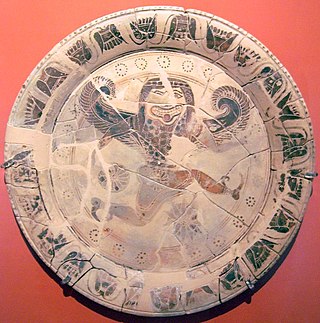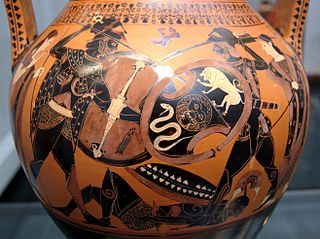
Black-figure pottery painting, also known as the black-figure style or black-figure ceramic, is one of the styles of painting on antique Greek vases. It was especially common between the 7th and 5th centuries BCE, although there are specimens dating as late as the 2nd century BCE. Stylistically it can be distinguished from the preceding orientalizing period and the subsequent red-figure pottery style.

The Nessos Painter, also known as Netos or Nettos Painter, was a pioneer of Attic black-figure vase painting. He is considered to be the first Athenian to adopt the Corinthian style who went on to develop his own style and introduced innovations. The Nessos Painter is often known to be one of the original painters of black-figure. He only worked in this style, which is shown on his name vase in the National Archaeological Museum in Athens. Most of the known Nessos Painter ceramics were found in funerary settings such as cemeteries and mortuaries.

The Athena Painter was an Attic black-figure vase painter, active about 490 to 460 BC. His speciality were white-ground lekythoi painted in the black-figure style.

The Painter of Berlin A 34 was a vase painter during the pioneering period of Attic black-figure pottery. His real name is unknown, his conventional name derived from his name vase in the Antikensammlung Berlin. He is the first individual vase painter of the style in Athens recognised by scholarship. His works are dated to circa 630 BC. Two of his vases were discovered in Aegina. Since the 19th century, those pieces were on display in Berlin, but they disappeared or were destroyed during the Second World War.

The KX Painter was an Attic black-figure vase painter. He was active between 585 and 570 BC. Besides the KY Painter, the KX Painter was the main representative of the Comast Group, which succeeded the Gorgon Painter. His conventional name was allocated by John Beazley. He is considered the better and chronologically somewhat earlier representative of the group. He was the first painter in Athens to occasionally depict komasts on his vases, a motif adopted from Corinthian vase painting. He mainly painted skyphoi, lekanes, kothones and Komast cups. In contrast to later representatives of the group, he still mostly painted animals, in a more careful and powerful style than the Gorgon Painter. Some mythological scenes by him are also known. Especially famous are his small-fornat mythical scenes placed within animal friezes. The KX Painter can be considered the first Attic painter to achieve a quality at par with that reached in Corinth, then the dominant centre of Greek vase painting. Imitations of his works are known from Boeotia.
The Panther Painter was a vase painter of the Attic black-figure style. He was probably active at the same time as the Nessos Painter, or shortly thereafter. Both shared a predilection for interlace patterns. The Panther Painter's vases have so far only been found in Attica, but outside Athens, at Vari. It is therefore assumed that he did not live and work in Athens, but only produced for a small local market in Attica. He mainly painted lekanis with animal friezes.

The Anagyros Painter or Anagyrus Painter was a vase painter of the early Attic black-figure style, active in the first quarter of the 6th century BC. His works have only been found in inland Attica, mainly at Vari, but not in Athens itself. It is thus assumed that he was not active within the city and only produced for a very limited rural area. In contrast to many of his contemporaries, he did not paint lekanes but various large formats, such as amphorae, kantharoi, chalices, oinochoai and plates.
The Painter of the Dresden Lekanis is the common name for a vase painter of the Attic black-figure style, active around 580–570 BC. He emigrated to Boeotia and is in fact identical with the Boeotian Horse-bird Painter.

The Polos Painter was a vase painter of the Attic black-figure style. His works date to c. 575 to 565 BC.

The Tyrrhenian amphora is a specific shape of Attic black-figure neck amphora. Tyrrhenian amphorae were only produced during a short period, about 565 to 550 BC. They are ovoid in shape and bear striking decorations. The handle is usually decorated with a lotus-palmette cross or vegetal tendrils. It always terminates in a red-painted ridge. The vase body is painted with several friezes. The uppermost of these, on the shoulder, is usually especially notable. It often contains mythological scenes, but the first erotic motifs in Attic vase painting also occur here. Unique motifs include the sacrifice of Polyxena. Often, the figures are explained by added inscriptions. The other friezes, usually two to three in number, are often decorated with animals. At times, a frieze is replaced with a vegetal band.

The Castellani Painter was an Attic vase painter of the black-figure style active in the second quarter of the sixth century BC.
The Princeton Painter was an Attic black-figure vase painter, active in the third quarter of the sixth century BC, just after Group E. His real name is not known.

The Painter of Munich 1410 was an Attic black-figure vase painter, active in the third quarter of the sixth century BC. His real name is not known. He was one of the late representatives of the black-figure style, which was in its final phase due to the introduction of red-figure vase painting. His conventional name is derived from his name vase, on display in the Staatliche Antikensammlungen at Munich. Although he is not considered an outstanding artist, some notable works are ascribed to him.

The Rycroft Painter was an Attic late black-figure vase painter, active in the final decade of the sixth century BC. His real name is not known.
The Hypobibazon Class was a group of Attic black-figure vase painters and a type of vase. They belong to the period around 510 BC.

The term Perizoma Group describes a group of Attic black-figure vase painters and a type of vase. They were active approximately 520–510 BC.

The Euphiletos Painter was an Attic black-figure vase painter active in the second half of the sixth century BC.

The Madrid Painter was an Attic black-figure vase painter active during the late period of the style, around 520 BC.

The Lysippides Painter was an Attic vase painter in the black-figure style. He was active around 530 to 510 BC. His conventional name comes from a kalos inscription on a vase in the British Museum attributed to him; his real name is not known.

The Edinburgh Painter was an Attic black-figure vase painter, active around 500 BC. His speciality was white-ground lekythoi painted in the black-figure style.
















